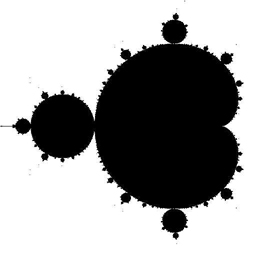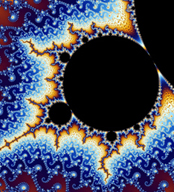Mandelbrot set is a set of complex numbers that do not diverge when a certain mathematical operation is applied to them.
A complex number zc = xc + i * yc is a part of a Mandelbrot set iff the sequence:
z(0) = 0
z(n + 1) = z(n) * z(n) + zc
is bounded, i.e. does not grow beyond a certain absolute value.
Mandelbrot sets can be visualized by mapping each pixel (x, y) of an image to a complex number xc + i * yc.
Since in practice we cannot exactly determine whether the sequence z(n) is bounded,
we compute its elements until either the absolute value of z(n) becomes larger than sqrt(2)
(meaning that the complex number will certainly diverge)
or we compute z(threshold), where threshold is the maximum number of iterations we allow
(meaning that the complex number will probably not diverge).
If we color pixels that diverged this way white and those that did not black, we obtain the following image:

This, however, is not very interesting – Mandelbrot set visualizations typically color pixels depending on their convergence rate, i.e. how many iterations were necessary to decide if the corresponding complex number converges or not.



Notice that rendering a Mandelbrot set image is trivially data-parallel – we can compute each
pixel independently of the other pixels.
Here’s how we can compute the number of iterations before deciding on convergence of a complex
number (xc, yc):
def compute(xc: Double, yc: Double, threshold: Int): Int = {
var i = 0
var x = 0.0
var y = 0.0
while (x * x + y * y < 2 && i < threshold) {
val xt = x * x - y * y + xc
val yt = 2 * x * y + yc
x = xt
y = yt
i += 1
}
i
}
The image is a discretized representation of the continuous Mandelbrot set, so we have to map
each pixel to a certain complex number.
Assume that the image represents the part of the real plane bounded with (xlo, xhi) and
(ylo, yhi) on x- and y-axes, respectively,
and that image width and height are wdt and hgt, respectively.
We transform each pixel (x, y) to (xc, yc) as follows:
val xc = xlo + (xhi - xlo) * x / wdt
val yc = ylo + (yhi - ylo) * y / hgt
If our image is represented in memory as an array of 32-bit values called pixels (of size wdt * hgt),
we can assign each pixel (x, y) to array entry y * wdt + x
and compute all the pixel values as follows:
for (idx <- 0 until (wdt * hgt)) {
val x = idx % wdt
val y = idx / wdt
val xc = xlo + (xhi - xlo) * x / wdt
val yc = ylo + (yhi - ylo) * y / hgt
val iters = compute(xc, yc, threshold)
val color = if (iters < threshold) 0xff000000 else 0xffffffff
pixels(idx) = color
}
Above we iterate through the range of all the pixel indices idx and convert
them to (x, y) coordinates.
This will render the pixels in the set black, and others white.
We can tweak the colors to reflect how many iterations were needed
to determine divergence, for example like this:
val a = 0xff << 24
val r = math.min(255, 1.0 * iters / threshold * 255).toInt << 16
val g = math.min(255, 2.0 * iters / threshold * 255).toInt << 8
val b = math.min(255, 3.0 * iters / threshold * 255).toInt << 0
val color = a | r | g | b
The Mandelbrot image is so far computed sequentially.
What if we now want to speed this up using p processors?
First, we need to instantiate a Scheduler that will execute
our operation in parallel.
This is done by first creating a (default) scheduler configuration
and then instantiating the scheduler itself.
We will be using the workstealing tree scheduler for this example:
import scala.collection.par._
val config = new workstealing.Scheduler.Config.Default(p)
implicit val s = new workstealing.Scheduler.ForkJoin(config)
Notice that the Scheduler must be implicitly available.
Second, we need to convert our range into its parallel correspondant,
by calling toPar on it.
The entire example now becomes:
val config = new workstealing.Scheduler.Config.Default(p)
implicit val s = new workstealing.Scheduler.ForkJoin(config)
for (idx <- (0 until (wdt * hgt)).toPar) {
val x = idx % wdt
val y = idx / wdt
val xc = xlo + (xhi - xlo) * x / wdt
val yc = ylo + (yhi - ylo) * y / hgt
val iters = compute(xc, yc, threshold)
val a = 0xff << 24
val r = math.min(255, 1.0 * iters / threshold * 255).toInt << 16
val g = math.min(255, 2.0 * iters / threshold * 255).toInt << 8
val b = math.min(255, 3.0 * iters / threshold * 255).toInt << 0
val color = a | r | g | b
pixels(idx) = color
}
You can see the complete code of this example here.
Rendering the Mandelbrot set is a particularly good example of how much better the workstealing tree scheduler is at irregular workloads. In particular, compared to existing Parallel Collections in Scala 2.9 and 2.10, the new scheduler can be up to 50% more efficient on an 8-core machine. If you would like to see the Mandelbrot computation in action, just play with the applet below, which allows switching between the classic parallel collections and the new scheduler.
